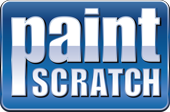Touch Up Paint Directions
How to Apply Touch Up Paint and Make Your Car Look Great
The most important instruction is to practice off the vehicle first! Perform all the steps below on another surface before applying any paint to your car. If you’re wondering whether you *can* really apply touch up paint and get a good result, the answer is yes — just take your time, follow the instructions, and you’ll be able to expertly repair car scratches using these simple touch up paint directions.
Learn visually? Click here to watch our how-to videos.
Warning
Automotive paint is very hazardous. Keep it away from children. Do *not* use any of the products until you have read and understand the product directions and warnings. We recommend wearing rubber gloves, a respirator, safety goggles, and working in a well-ventilated area. Interior paint is vinyl based and does *not* require clear coat or polishing.
PaintScratch, Inc. is not responsible for your results using our paint products. We recommend consulting a professional auto-body repair person before attempting to repair your vehicle. Results may vary.
Shelf Life & Storage
Brush cap bottles and paint pens have a shelf life of one year or more. However, if stored in a warm place the paint can dry up even if unopened. Don’t store the paint in your glove box — store in a cool, dry place. Spray cans have longer shelf life but the nozzle will clog if not cleaned properly.
How to Repair Car Paint – Steps to Success
- Find and order your car paint. We sell over 100,000 car paint colors and all painting accessories.
- Test the color match, and practice. Before applying to your car, test the auto paint on another surface (metal can, old sign) and let it dry. If it looks good, you’re ready.
- Choose the right painting conditions. For best results, paint in low humidity, out of direct sunlight. Minimum ~50 °F for brush/pen, and ~70 °F for spray cans.
- Prepare your car. Clean the area with soap or wax & grease remover. If the surface is rusty, remove rust with 220-grit sandpaper or wire brush, then apply rust treatment as needed.
- Apply primer. On bare metal or plastic use a thin coat of primer, let it dry at least 20 minutes to overnight. Never use enamel primer.
- Apply the basecoat (your paint color). Apply several thin coats so the repaired area matches the surrounding paint level. Let it dry at least 20 minutes to overnight.
- Apply clearcoat. Several thin layers of clearcoat, letting each dry 10-20 minutes. When spray applying, “float” the clearcoat over basecoat; too much pressure will disturb the underlying paint.
- Polish with rubbing compound. Wait at least three days before applying rubbing compound (aka cutting-creme) to the repaired area to make it smooth & shiny. Wait 30 days before waxing the area.
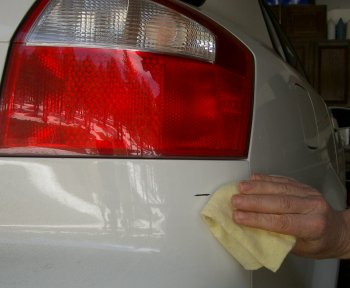
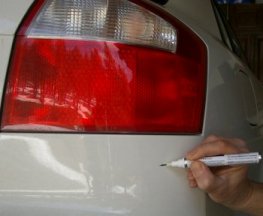
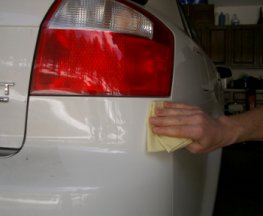
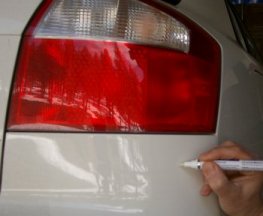
Detailed Touch Up Paint Directions
We have created detailed directions for specific product types so you get the best results:
- Detailed Paint Pen Instructions
- Detailed Brush Cap Bottle Instructions
- Detailed Spray Can Instructions
- More Tri-coat (base/mid/clearcoat) Information
- Using Your Own Spray Equipment
- Water Based Paint Information
- Blending the Paint
Touch Up Paint Tips, Suggestions & Tricks
- The pints, quarts and gallons of basecoat, mid-coat, clear and primer are ready to spray and do not require thinning.
- If you get paint on your skin, remove with automotive lacquer thinner and wash thoroughly with soap & water.
- Do not try to use a paint pen on an area larger than a pencil eraser. For larger areas, use a spray can.
- Do not try to brush areas larger than a dime—larger areas should be sprayed.
- Always test compatibility in an inconspicuous part of the vehicle first.
- Do not apply our paint over enamel paint or enamel primer.
- Do not spray primer, paint or clearcoat in direct sunlight.
- If you’re new, know that you can **completely remove any new paint** with automotive lacquer thinner and start over without damaging the original finish.
- Use an approved automotive paint respirator, safety goggles and gloves when handling paint to protect eyes and skin.
Additional Touch Up Paint Directions & Technical Info
Testing the Paint Color Match
Always test the paint before applying it to your vehicle! If the color is off, the clearcoat or primer will *not* make the color match better. Test first on an inconspicuous part. If the match isn’t perfect, consider professional assistance.
Practice Applying Touch Up Paint
Practice on a surface like a metal can or glossy paper to get used to the paint and check color match. Use several light coats instead of one heavy coat. Let the paint dry completely. If you want an excellent repair—don’t skip practicing!
Paint Pens, Brush Bottles & Spray Cans
Do *not* try to use a paint pen on areas larger than a pencil eraser. For brush bottles, avoid areas larger than a dime. Metallic paints applied by pen/brush often look darker because the metallic flakes won’t lay down properly—so for larger areas, always use a spray can.
Spray Painting — Humidity & Temperature Warning
Don’t spray in wet/humid conditions or direct sunlight. Test humidity by applying a small amount of clearcoat—if you get a white haze or streaks, conditions are too humid. Ideal: temperature at least 70 °F and humidity below 50 %. Above ~80 °F, paint may dry before hitting the surface and leave a rough texture.
Drying Times for Touch Up Paint
It’s important to let the basecoat fully dry before applying the clearcoat, and to let the clearcoat dry before polishing. Usually at least 20 minutes to overnight is sufficient, but drying time varies with temperature—if under 70 °F, it may take much longer.
Car Paint Compatibility Warning
If your vehicle was recently painted at a low-cost shop, our paint might lift the existing finish. If in doubt, test a small area for lifting before re-coating the full part.
Key Scratches in Auto Paint
Paint pens are ideal for key scratches since you can easily control the paint amount and follow the scratch. After basecoat & clearcoat, use rubbing compound to polish and shine the area. Be sure to “float” the clearcoat—too much pressure will remove the basecoat.
Primer for Repairing Scratches
For bare metal, plastic, or rubber surfaces, apply a good primer. On flexible surfaces (rubberized bumper) sprayed paint should include an adhesion promoter prior to primer. For flexible surfaces, adhesion promoter is only required when spraying (not needed for pen/brush touch-ups).
Fiberglass Scratch Repair Directions
Treat fiberglass rigid parts like metal. For non-metal surfaces you can still use adhesion promoter for maximum durability. Clean the area, apply primer, then basecoat just like metal.
Powder Coating Scratch Repair Directions
Powder coatings are urethane, cured and baked. Clean the area, wet-sand with 220 → 600 grit, apply primer if scratch is deep, then basecoat. Ensure our paint won’t wrinkle or lift the finish—test before full application.
Using Your Own Spray Equipment
Our pints, quarts and gallons of primer/basecoat/midcoat/clearcoat are ready to spray and don’t require thinning. For 2-oz size used in spray guns: tip size 1.0 mm for airbrush, 1.2-1.3 mm for spray gun. Thin with one part automotive lacquer thinner to one part paint if required.
Cleaning Your Equipment
Use automotive lacquer thinner for solvent-based paints or soap & water for water-based paints. Check if your paint mixes with water; if so, clean with soap & water.
Tri-Coat Car Paint Repair Directions
If your color has “Tri-coat” in the description, you’ll need to apply three steps: basecoat, mid-coat, then clearcoat. Practice first.
Lightening/Darkening Effects When Spraying Clearcoat
Changing spray distance can affect appearance: to lighten the paint hold sprayer farther; to darken hold closer. Practice this technique off the car first.
Waxing After Applying Touch Up Paint
Wait 30 days after your repair before waxing the area for best gloss retention.
Storing Car Paint – How to Store Touch Up Paint
Store in a cool, dry place. Never leave bottles in your vehicle where heat can dry them up. Some even store them in the refrigerator (if your spouse allows!). Never freeze the paint.
Hazards & Safety – VERY IMPORTANT!
Automotive touch-up paint (including primer and clearcoat) is extremely hazardous. Keep away from children. If swallowed call a doctor immediately. Avoid direct sunlight and heat over 120 °F. Contains chemicals known to the state of California to cause birth defects or cancer. Use proper ventilation, respirator, goggles and gloves.
Ready to Order?
Select your vehicle year, make, and model to find the exact touch up paint color.
